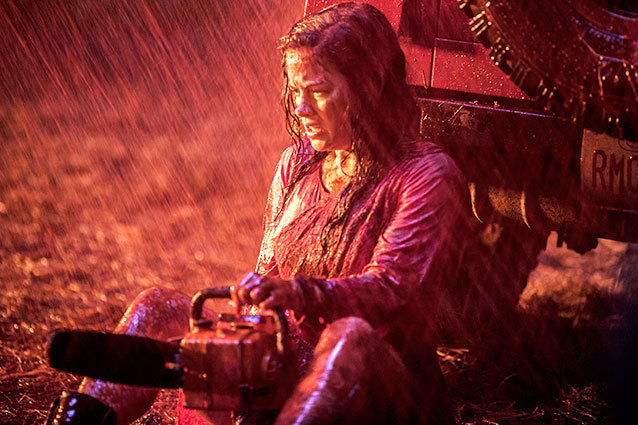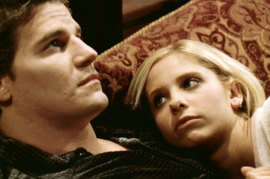
WARNING: The following posts contains major spoilers for Evil Dead.
Evil Dead fans have been gobbling up every tidbit of information about the 2013 remake of Sam Raimi’s 1981 camp thriller, including the biggest twist on the theme: replacing Bruce Campbell’s Ash as the star of the movie with Jane Levy’s possessed Mia. The shift in focus was an easy peg for celebration on the part of women seeking a more level gender playing field in horror. Mia is giving us a potentially feminist alternative to Ash, but the change could also be a simple refresh button choice on the part of director Fede Alvarez. It’s Mia blood-drenched moments in the final half hour of the film that truly makes the role far more prominent and begs the question, does Mia’s powerful role change things for women in horror?
RELATED: ‘Evil Dead’ Softens Tree Rape, But Is It Any Better?
The answer is slightly more complicated than a straight “yes.” At the end of the film, Mia is buried by her brother as a means of killing the demon inside of her and when she comes back as herself, she’s eventually the only living member of her group of friends, forced to defeat the demon herself. Mia not only takes Ash’s role as the star, she takes his role as the movie’s central badass, and one who eventually sends the demon back to hell with a blood-covered chainsaw as blood rains from the sky. She’s resourceful, smart, and when she’s backed into a corner, she’s the one with the last minute surprise that saves the day: She rips off her own hand when she’s trapped (also an homage to Ash) instead of being rescued by a miraculously surviving friend with the element of surprise (like the spectacled buddy who saves her brother David earlier in the film). Basically, Mia not only survives: she absolutely pummels evil.
 Still, she’s not the shining beacon of feminism, exactly. This last-ditch effort could be categorized somewhat broadly as the classic horror trope of the “final girl.” She’s the last one standing, she’s rarely the blonde, and she steps up to defend herself in the face of death. It’s a story we’ve seen again and again, but up until characters Buffy Summers won our hearts on Buffy: The Vampire Slayer, the final girl was generally the mousy brunette whose purity was her main trait. Buffy (as well as characters like Sidney from the Scream movies) was very sexually active, dispelling the notion that the final girl had to be chaste. Like Sarah Michelle Gellar’s heroine before her, Levy’s character takes it a step further.
Still, she’s not the shining beacon of feminism, exactly. This last-ditch effort could be categorized somewhat broadly as the classic horror trope of the “final girl.” She’s the last one standing, she’s rarely the blonde, and she steps up to defend herself in the face of death. It’s a story we’ve seen again and again, but up until characters Buffy Summers won our hearts on Buffy: The Vampire Slayer, the final girl was generally the mousy brunette whose purity was her main trait. Buffy (as well as characters like Sidney from the Scream movies) was very sexually active, dispelling the notion that the final girl had to be chaste. Like Sarah Michelle Gellar’s heroine before her, Levy’s character takes it a step further.
RELATED: ‘Evil Dead’ and Hollywood’s Goriest Moments
Mia, whose trip to the ill-fated cabin where she will spend the worst night of her life was inspired by her recent near fatal overdose of cocaine, is somewhat of a degenerate. She’s not a sweet babysitter or a straight-A student or some pure being about to be corrupted, like Cheryl who served as the devil’s vessel in the original The Evil Dead. And with that, she’s opening the definition of the final girl even further. It’s something horror expert and Women in Horror Month founder Hannah Neurotica (Forman to the non-horror community) says is happening more and more in the genre, “One of the things about the final girl, back then, was that she didn’t do drugs, she didn’t have sex, she didn’t do anything immoral. Now we’re seeing more of a shift that girls aren’t actually going to be punished for engaging in those activities.”
And that’s just it. Generally, the more free-spirited, sexual girls generally go down first or at least earlier in the hierarchy of horror movie slayings, while the good girl is the one who triumphs. To some extent, Evil Dead doesn’t abolish that tendency. Take Natalie (Elizabeth Blackmore) in Evil Dead: the ditzy, blonde girlfriend of Mia’s brother David (Shiloh Fernandez) is scoffed at by nurse and know-it-all Olivia (Jessica Lucas) as yet another of David’s many girls. She’s primed for falling prey to the villain (or devil taking possession of anyone he can get his hands on, in this case). She’s not a prime candidate to be the final girl and that’s still the case. That being said, she’s certainly more of a “good girl” than drug-addled Mia, who isn’t exactly set up for the final girl slot either.
For Levy’s heroine, the places at which she breaks the conventions of the final girl aren’t limited to her nasty little habit. Unlike final girls before her, including Jamie Lee Curtis’ classic Laurie from the Halloween series, Mia isn’t a babysitter with no need for depth or a backstory. She is full of rage, built on the notion that her brother abandoned her when their mother was dying in the hospital. We sort of connect the bridge between her anger over her past and her life-threatening dependence on drugs, and suddenly, she’s not just a vessel for the spirits awakened by the book of the dead. She’s a full character who comes into the film with her own agenda, acting out motivations and demons of her own. In many ways, she’s introducing that side of horror to a mainstream audience thanks to a wave that has been building and continues to build in the genre.
Of course, it must be stated that Mia isn’t some heroine gleaming in the face of a misogynistic genre. She’s a member of a growing group — and a sign that the shift that began with final girls like Alien’s Ripley is not so much a trend (which implies that it’s a temporary wave), but a permanent change in the fabric of mainstream horror. “A lot of horror films now are taking the character of the final girl and experimenting with it and taking it in different directions and that is a feminist act regardless of whether or not it was intended because it’s allowing women to have more to them and a role in the genre and that alone is progress,” says Neurotica.
RELATED: ‘Evil Dead’ & Other Movies With 100% on Rotten Tomatoes
It’s something that touches all areas of the genre, not just Evil Dead’s slasher category. In television we’re seeing characters like The Walking Dead‘s Michonne and any character Jessica Lange plays on American Horror Story acting as not only formidable presences on screen, but as actual draws for audiences. Entire movie franchises like Underworld and Resident Evil are built on the shoulders of women fighting the forces of horror. Part of that can be attributed to the fact that, well, Kate Beckinsale looks pretty hot fighting vampires. The other factor is that the base of horror fans is diversifying, and fast.
A quick look at TV ratings for horror hits proves that. According to Ad Week, Walking Dead draws more women than supposedly lady-friendly shows like The Real Housewives of Atlanta or New Girl, and Fox’s bloody serial killer drama The Following ranks high among women as well. And of course, there’s the Resident Evil series, which is a billion dollar franchise and has plenty of female fans of its own. Horror that pleases both sexes by delivering full characters with depth as well as guts on both sides of the gender divide isn’t just a step for leveling the playing field and raising the bar on quality horror, it’s a necessary way to make sure a film appeals to the full breadth of horror fans.
Evil Dead‘s Mia may not be breaking ground, but she’s performing the very important task of keeping the progression of strong women in horror moving forward. The more opportunities we have to see a woman so badass she’ll rip off her own hand to kill the devil, the better.
Follow Kelsea on Twitter @KelseaStahler
[Photo Credit: TriStar Pictures; 20th Century Fox Television]
From Our Partners: 40 Most Revealing See-Through Red Carpet Looks (Vh1)
40 Most Revealing See-Through Red Carpet Looks (Vh1) 33 Child Stars: Where Are They Now? (Celebuzz)
33 Child Stars: Where Are They Now? (Celebuzz)


